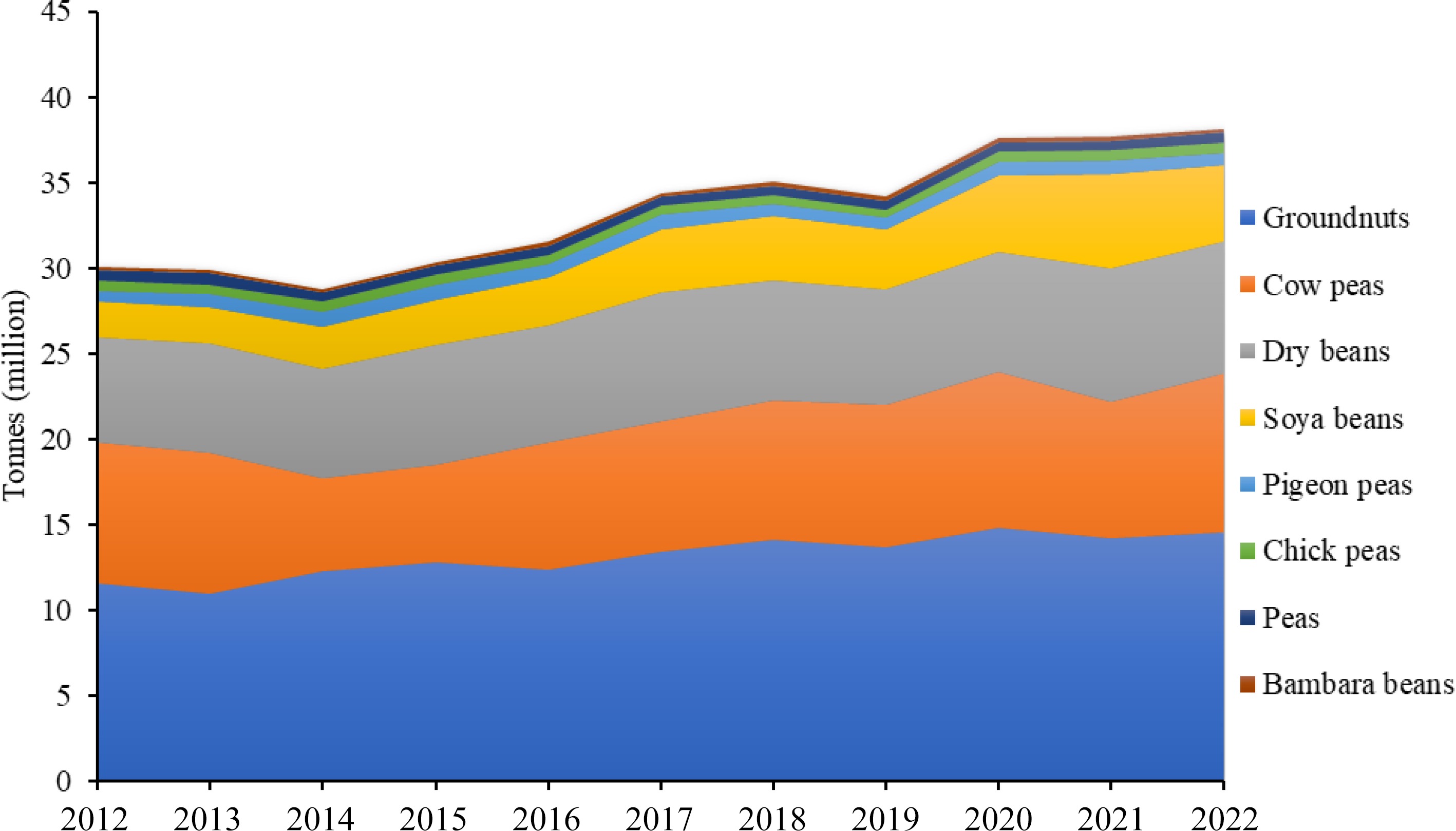-

Figure 1.
(a) Mungbean seeds, (b) flower, (c) developing pods, and (d) field crop[8].
-

Figure 2.
Annual production of major pulse crops in Sub-Saharan Africa during the period between 2012 and 2022 (M Mg). Source: FAOSTAT[41].
-
Country N fixed
(kg N ha−1)N method used* Ref. Pakistan 55–86 N balance [19] Pakistan 35–83 15N isotope dilution [20] Philippines 25–47 15N isotope dilution [21] Philippines 21–85 15N isotope dilution [22] Philippines 61–90 15N isotope dilution [23] Philippines 21–85 15N isotope dilution [24] Thailand 35–50 15N isotope dilution [25] Thailand 10 15N isotope dilution [26] Australia 20–83 15N natural abundance [27] Ethiopia 8–25 15N natural abundance [28] Pakistan 32–46 15N natural abundance [29] Pakistan 41 15N natural abundance [30] Thailand 64–66 15N natural abundance [31] Pakistan 6–32 Ureide [32] Pakistan 17–47 Ureide [33] Pakistan 55 Ureide [30] Pakistan 19–47 Ureide [34] Pakistan 13–26 Ureide [35] * See Unkovich et al.[36] for description of techniques for measuring biological N2 fixation. Table 1.
Estimates of fixed N by mungbean in field trials.
-
Crop Protein (g) Oil (g) Calcium (mg) Iron (mg) Zinc (mg) Vitamin A (mcg-RAE) Vitamin
C
(mg)Folate (mcg) Mungbean 26 1 145 7 3 7 5 687 Mungbean sprout 32 2 135 9 4 10 138 635 Chickpea 22 7 119 7 4 3 5 630 Cowpea 27 2 96 11 7 2 2 718 Groundnut 28 53 98 5 3 0 0 257 Kidney bean 27 1 162 9 3 0 5 446 Pigeon pea 21 5 123 5 3 9 114 507 Soybean 40 22 303 17 5 1 7 410 Soybean, green 40 21 606 11 3 28 89 508 * Value per 100 g raw product (dry weight basis). Source: (USDA, 2010). Table 2.
Absolute nutritional content (in g or mg) of major crop legumes grown in Africa and Asia*.
-
Amino acid (g/16 g of nitrogen) Average* Minimum Maximum Alanine 4.1 3.6 4.5 Arginine 5.8 4.5 6.7 Aspartic acid 13 12 15.1 Cysteic acid 13.5 13.5 13.5 Glutamic acid 18.3 13.6 21.7 Glycine 3.6 3.2 4.3 Histidine 3.2 2.4 5.6 Isoleucine 4.3 3.6 5.4 Leucine 7.6 6.9 8.7 Lysine 6.5 4.1 8.1 Methionine 1.2 0.5 1.9 Phenylalanine 5.4 4.6 6.2 Proline 4.5 3.7 5.6 Serine 4.9 4 5.8 Threonine 3.2 2.7 4 Tryptophan 1.2 0.5 3.4 Tyrosine 2.7 2.2 3.3 Valine 5.1 4.1 6.4 * Mean value of all collected data[60]. Table 3.
Amino acid composition of mung bean.
-
Category Uses Description Food Whole seeds Mungbean seeds are commonly boiled and consumed as a side dish or with cereals such as rice or millet. Split seeds (Dhal) In South Asia, mungbean seeds are split to make dhal, a thick soup served with rice or bread. Sprouts Mungbean seeds are sprouted and eaten in salads, sandwiches, or stir-fried dishes, rich in vitamins and minerals. Noodles and soups Mungbean flour is used to make glass noodles and soups in Asian cuisines, particularly in China and Southeast Asia. Desserts and sweets Mungbean is used in making traditional sweets like cakes and jellies, especially in Asian countries. Flour Mungbean seeds are ground into flour, used in baking, or mixed with wheat flour to increase the protein content of baked products. Baby food supplements Mungbean flour, rich in protein and iron, is used as a supplement in baby food products to improve nutritional quality. Fermented foods Mungbean is used in the fermentation process to create food products like tempeh, which are rich in probiotics and proteins. Feed Livestock fodder Mungbean residues (leaves and stems) are fed to livestock, providing a high-protein feed that supports meat and milk production. Green manure Mungbean is grown as a cover crop, and its biomass is incorporated into the soil as green manure, enriching the soil with organic matter and nutrients. Non-food Trap crop for pest management Mungbean is used as a trap crop in integrated pest management systems to reduce pest populations on cash crops like cotton. Soil improvement
(nitrogen fixation)As a legume, mungbean fixes atmospheric nitrogen, enhancing soil fertility for subsequent crops in crop rotation systems. Erosion control When used as a cover crop, mungbean helps reduce soil erosion by stabilizing the soil surface and reducing water runoff. Industrial applications
(starch production)Mungbean starch is extracted and used in the production of biodegradable plastics, cosmetics, and other industrial applications. Table 4.
Food, feed, and non-food uses of mungbean.
Figures
(2)
Tables
(4)